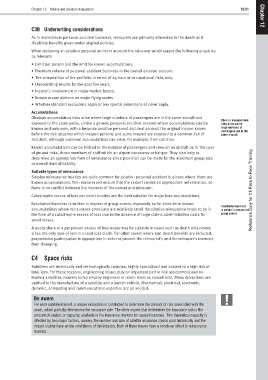Page 351 - M97TB9_2018-19_[low-res]_F2F_Neat2
P. 351
Chapter 12 Marine and aviation reinsurance 12/21 Chapter
C3B Underwriting considerations 12
As in mainstream personal accident business, reinsurers are primarily interested in the death and
disability benefits given under original policies.
When reviewing an aviation personal accident account the reinsurer would regard the following enquiries
as relevant:
• Limit per person and the limit for known accumulations.
• Premium volume of personal accident business in the overall aviation account.
• The composition of the portfolio in terms of 24-hour or occupational risks only.
• Underwriting results for the past five years.
• Insurer’s involvement in major market losses.
• Known accumulations on major flying routes.
• Whether standard exclusions apply or any special extensions of cover apply.
Accumulations
Obvious accumulation risks arise where large numbers of passengers are in the same aircraft and
Obvious accumulation
exposed to the same perils. Unlike a generic personal accident account where accumulations can be risks arise where
known and unknown, with a bespoke aviation personal accident account the original insurer knows large numbers of
passengers are in the
before the risk attaches which insured persons and sums insured are exposed to a common risk of same aircraft
accident, although unknown accumulations can arise, for example, from collision.
Known accumulations can be limited to the number of passengers and crew on an aircraft or, in the case
of ground risks, those members of staff within an airport concourse or hangar. They also help to
determine an appropriate form of reinsurance since provision can be made for the maximum group size
or overall limit of liability.
Suitable types of reinsurance
Surplus reinsurance treaties are quite common for aviation personal accident business where there are
known accumulations. The reinsurer will ensure that the cedant carries an appropriate net retention, so
there is no conflict between the interests of the cedant and reinsurer. Reference copy for CII Face to Face Training
Catastrophe excess of loss per event treaties are the best solution for major loss accumulations.
Facultative business is written in respect of group covers, especially so for short-term known
Facultative business
accumulations where reinsurance premiums are relatively small. Facultative reinsurance tends to be in is written in respect of
the form of a catastrophe excess of loss due to the absence of large claims administration costs for group covers
small losses.
A quota share or a per person excess of loss treaty may be suitable in cases such as death only covers
since the only type of loss is a total loss claim. For other covers where non-death benefits are included,
proportional participation is appropriate in order to prevent the reinsured’s and the reinsurer’s interests
from diverging.
C4 Space risks
Satellites are technically and technologically complex, highly specialised and subject to a high risk of
total loss. For these reasons, engineering issues play an important part in risk assessment and so
leading satellites insurers today employ engineers or retain them as consultants. Many disciplines are
applied to the manufacture of a satellite and a launch vehicle. Mechanical, electrical, electronic,
dynamic, computing and communications expertise are all needed.
Be aware
For each satellite insured, a unique evaluation is conducted to determine the amount of risk associated with the
asset, which partially determines the insurance rate. The other aspect that determines the insurance rate is the
amount of capital, or capacity, available in the insurance markets for space insurance. This theoretical capacity is
affected by two major factors, namely, the number and size of satellite insurance claims paid historically and the
impact claims have on the confidence of the industry. Both of these issues have a knock-on effect to reinsurance
markets.

